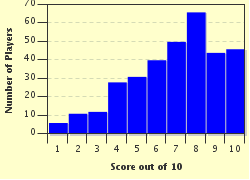Quiz Answer Key and Fun Facts
1. Each of these Royal Palaces is a major landmark within their respective countries. With which of them would you associate the Sun King?
2. Bridges are another much photographed structure around the world. Which of these four listed is the oldest?
3. Three of these famous world sites were built for some form of ancient worship. Which is the only one that WASN'T?
4. Which of the following landmarks is the only one that is found outside of the United Kingdom?
5. Mausoleums are another type of monument that visitors flock to see. Which of these famous buildings is a temple and NOT a mausoleum?
6. Areas of natural beauty and wonder also have a high spot on tourists' 'must see' lists. With which of these famous natural wonders would you associate Tenzing Norgay?
7. Our next four landmarks were all built by ancient civilisations. Which one is NOT a famous ruin?
8. These buildings are all monuments in Asia for different religions. Which one would you visit if you were interested in viewing a place of worship for the Sikhs?
9. Which of these famous statues is the only one that is NOT made primarily of a metal?
10. Last, but definitely not least, are the magnificent fountains that adorn most cities around the world. Which of the following four is the only one that you would find in the USA?
Source: Author
Midget40
This quiz was reviewed by FunTrivia editor
stedman before going online.
Any errors found in FunTrivia content are routinely corrected through our feedback system.

